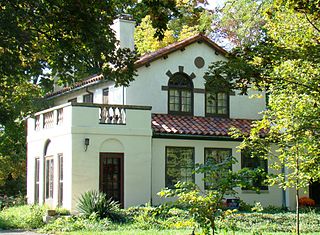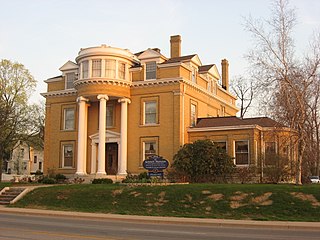
Chatham–Arch is a neighborhood located immediately east of Downtown Indianapolis, Indiana, United States. This neighborhood is one of the oldest in Indianapolis, dating back to the mid 19th century. Chatham–Arch contains many of Indianapolis's historic homes.

The Reeveston Place Historic District is a neighborhood of homes and national historic district located at Richmond, Wayne County, Indiana. It was platted in 1911 on land formerly owned by the family of Mark Reeves and the district encompasses 218 contributing buildings, 1 contributing site, and 2 contributing objects. The architecture is an eclectic mix of styles including Craftsman and English cottages, and impressive homes in the Colonial Revival, Tudor Revival, Georgian, French, Spanish and Ranch styles. The original Reeves home in the Second Empire style survives as well.

The Starr Historic District is a neighborhood of historic buildings and national historic district located at Richmond, Wayne County, Indiana. The district encompasses 102 contributing buildings in a predominantly residential section of Richmond. It developed between about 1853 and 1915 and includes representative examples of Greek Revival, Italianate, Second Empire, and Queen Anne style architecture. Included in the district is a former Hicksite Quaker Meeting House, now the Wayne County Historical Museum and the Reid Memorial Presbyterian Church and Andrew F. Scott House. Other notable buildings include the Miller-Mendenhall House (1875), Dickinson Log House (1825), Starr-Cadwalader House (1861), and Clem Gaar House (1883).

The Richmond Railroad Station Historic District is a group of historic commercial buildings and national historic district located at Richmond, Wayne County, Indiana. The district encompasses 22 contributing buildings the icon of which is the Daniel Burnham-designed Pennsylvania Railroad Station, completed in 1902. It developed between about 1853 and 1915 and includes representative examples of Italianate, Classical Revival, and Chicago School style architecture. In addition to the Pennsylvania Railroad Station, other notable buildings include the Miller Brothers Block (1890), Jacob H. Lichtenfels Building (1890), Charles Sudhoff Building (1893), Benjamin Starr Building (1896), William H. Alford Building (1905), John Roberts Building (1877), R.F.D. Hose House No. 1 (1890), James Shaw Building (1875), and Richmond / Atlas Underwear Building (1910).

The East Main Street–Glen Miller Park Historic District is a neighborhood of historic residential buildings and national historic district located at Richmond, Wayne County, Indiana. The district encompasses 84 contributing buildings, 11 contributing structures, and 5 contributing objects along the National Road and sometimes called Millionaire's Row. A portion of the district is recognized by the City of Richmond's Historic Preservation Commission as the Linden Hill conservation district. It developed between about 1830 and 1937 and includes representative examples of Italianate, Queen Anne, Colonial Revival, Tudor Revival, Classical Revival, and Bungalow / American Craftsman style architecture. Located in the district is the separately listed Henry and Alice Gennett House. Other notable contributing resources include elaborate iron bridges and "Madonna of the Trail" statue located in Glen Miller Park, Isham Sedgwick House (1884-1885), John A. Hasecoster House (1895), William H. Campbell House (1905), Howard Campbell House (1909), E.G. Hill House, Crain Sanitarium, and Dr. T. Henry Davis House.

Forest Hills Historic District is a national historic district located at Indianapolis, Indiana. It encompasses 173 contributing buildings and 7 contributing structures in a planned residential section of Indianapolis. It developed between about 1911 and 1935, and includes representative examples of Tudor Revival and English Cottage style architecture.

The Richmond Downtown Historic District is an area of primarily commercial buildings and national historic district located at Richmond, Wayne County, Indiana. The district encompasses 47 contributing buildings located along the National Road. It developed between about 1868 and 1960 and includes representative examples of Italianate, Romanesque Revival, Queen Anne, Classical Revival, and Chicago School style architecture. Located in the district is the separately listed Murray Theater. Other notable buildings include the I.O.O.F. Building (1868), Hittle Building (1878), Tivoli Theater (1926), Romey's Building (1920), George H. Knollenberg Building (1877), Kresge Building, Dickinson Building (1880), former U.S. Post Office (1905), and YMCA (1908).

St. Vincent Villa Historic District is a national historic district located at Fort Wayne, Indiana. The district encompasses nine contributing buildings and one contributing site associated with a Catholic orphanage. The buildings were constructed between 1932 and 1950–1951, and include notable examples of Mission Revival, Romanesque Revival, and Bungalow / [[AFort Wayne Newspapers American Craftsman]] style institutional architecture. They include the Main Building (1932), four cottages, the Boiler House (1932), and two bungalows. The property was sold by the Roman Catholic Diocese of Fort Wayne–South Bend to the YWCA of Fort Wayne in the 1970s.

Brookville Historic District is a national historic district located at Brookville, Franklin County, Indiana. The district encompasses 682 contributing buildings in the central business district and surrounding residential sections of Brookville. It developed between about 1811 and 1913, and includes notable examples of Federal and Greek Revival style architecture. Located in the district are the separately listed Franklin County Seminary and The Hermitage. Other notable contributing buildings include the James Brown Ray House (1811-1820), Old State Bank, James N. Tyner House, Old Brick Meeting House (1810-1821), Franklin County Courthouse (1853-1859), St. Michael's Catholic Church, Howland-Farquahar-Goodwin House (1855), Valley House Hotel (1842), and the Presbyterian Church (1854-1855).

East Shore Historic District, also known as Lake Maxinkuckee Historic District, is a national historic district located in Union Township, Marshall County, Indiana. The district encompasses 114 contributing buildings, 3 contributing sites, and 1 contributing structure in a resort development along the shore of Lake Maxinkuckee. It developed between about 1873 and 1945, and includes examples of Late Victorian, Colonial Revival, and Bungalow / American Craftsman style architecture. The district includes Maxinkuckee Country Club. Notable buildings include the Norris Farmhouse, Trone Cottage, Roach-Rockwood Cottage, Elliott Cottage, Gates-Holliday Cottage (1897), Marmon Cottage, and Norman Perry House.

Highland Park Neighborhood Historic District is a national historic district located at Lafayette, Tippecanoe County, Indiana. The district encompasses 240 contributing buildings, 1 contributing site, and 1 contributing structure in a planned residential subdivision of Lafayette. It developed between about 1892 and 1945 and includes representative examples of Queen Anne, Tudor Revival, and Bungalow / American Craftsman style architecture. Notable contributing resources include the Blistain Axel Merritt House (1914), John Wagner Jr. House, John Ross House, and Bicycle Bridge (1924).

Ninth Street Hill Neighborhood Historic District is a national historic district located at Lafayette, Tippecanoe County, Indiana. The district encompasses 88 contributing buildings and 6 contributing structures in a predominantly residential section of Lafayette. It developed between about 1850 and 1946 and includes representative examples of Gothic Revival, Italianate, Queen Anne, Greek Revival, and Second Empire style architecture. Located in the district is the separately listed Judge Cyrus Ball House. Other notable contributing resources include the Samuel Moore House (1891), Moore-Porter-Boswell House (1895), Stanley Coulter House (1890), Edward Bohrer House (1909), Thomas Wood House, Job M. Nash House (1859), and Gordon Graham House.

Perrin Historic District is a national historic district located at Lafayette, Tippecanoe County, Indiana. The district encompasses 173 contributing buildings and 2 contributing structures in a predominantly residential section of Lafayette. It developed between about 1869 and 1923 and includes representative examples of Italianate, Queen Anne, Colonial Revival, Stick Style / Eastlake Movement, and Bungalow / American Craftsman style architecture. Notable contributing buildings include the James Perrin House, John Heinmiller House, James H. Cable House, Adam Herzog House (1878), Coleman-Gude House (1875), Frank Bernhardt House (1873), August Fisher Cottage, John Beck House (1887), an William H. Sarles Bungalow (1923).

Hills and Dales Historic District is a national historic district located at West Lafayette, Tippecanoe County, Indiana. The district encompasses 136 contributing buildings and 39 noncontributing buildings in a predominantly residential section of Lafayette, platted in 1922–1924. It developed between about 1911 and 1951 and includes representative examples of Colonial Revival, Tudor Revival, French Renaissance, and Ranch style architecture. Notable contributing buildings include the Haniford House, Herbert Graves House,, and Marion J. Eaton House.

Dayton Historic District is a national historic district located at Dayton, Indiana,, Tippecanoe County, Indiana. The district encompasses 82 contributing buildings and 1 contributing site in the central business district and surrounding residential sections of Dayton. It developed between about 1830 and 1952 and includes representative examples of Greek Revival, Italianate, Second Empire, and Bungalow / American Craftsman style architecture. Notable contributing resources include the Lantz Building (1941), Reincke-Hawkins House, Castle Block (1894), Baker-Yost House, First Presbyterian Church (1899), and Gladden-Goldsbury House.

Boonville Public Square Historic District is a national historic district located at Boonville, Warrick County, Indiana. It encompasses 50 contributing buildings in the central business district of Boonville. It developed between about 1855 and 1934, and includes representative examples of Italianate, Beaux-Arts, Queen Anne, Tudor Revival, and Art Deco style architecture. Located in the district is the separately listed Old Warrick County Jail. Other notable buildings include the Warrick County Courthouse (1904), Boonville Standard (Mellen) Building (1902), I.O.O.F. Building (1896), Peoples' Bank (1939), Carnegie Library (1918), Trimble Block (1903), and Farmers & Merchants Bank (1902).

North Meridian Street Historic District is a national historic district located at Indianapolis, Indiana. It encompasses 169 contributing buildings in a high style residential section of Indianapolis. The district developed between about 1900 and 1936, and includes representative examples of Tudor Revival, Colonial Revival, and Classical Revival style architecture. Located in the district is the separately listed William N. Thompson House. Other notable contributing resources include the Evan-Blankenbaker House (1901), Sears-Townsend House (1930), MacGill-Wemmer House, Hugh Love House (1930), Hare-Tarkington House (1911), Shea House (1922), and Brant-Weinhardt House (1932).

Holy Rosary–Danish Church Historic District, also known as Fletcher Place II, is a national historic district located at Indianapolis, Indiana. The district encompasses 183 contributing buildings in a predominantly residential section located in the central business district of Indianapolis. It was developed between about 1875 and 1930, and include representative examples of Italianate, Gothic Revival, Tudor Revival, and Renaissance Revival style architecture. Located in the district is the separately listed Horace Mann Public School No. 13. Other notable buildings include the John Kring House, Trinity Danish Evangelical Lutheran Church (1872), John Wands House (1857), Henry Homburg House, Samuel Keely House, Maria Wuensch Cottage, and Holy Rosary Catholic Church (1911-1925).

Shortridge–Meridian Street Apartments Historic District is a national historic district located at Indianapolis, Indiana. The district encompasses 136 contributing buildings in a predominantly residential section of Indianapolis. It was developed between about 1900 and 1951, and includes representative examples of Colonial Revival, Classical Revival, Late Gothic Revival, Mission Revival, Renaissance Revival, Bungalow / American Craftsman, and Art Deco style architecture. Located in the district is the separately listed Shortridge High School. Other notable buildings include the Vernon Court Apartments (1928), Fronenac Apartments (1951), Biltmore Apartments (1927), Meridian Apartments (1929), New Yorker Apartments (1917), Howland Manor (1929), Powell-Evans House (1911), Harms House (1906), Dorchester Apartments (1921), and Martin Manor Apartments (1916).

Watson Park Historic District, also known as Watson Road Historic District and Watson McCord Neighborhood, is a national historic district located at Indianapolis, Indiana. The district encompasses 402 contributing buildings and 4 contributing sites in a predominantly residential section of Indianapolis. They include 255 houses, 27 multiple family dwellings, and 120 garages. It was developed between about 1910 and 1960, and includes representative examples of Colonial Revival, Tudor Revival, and Bungalow / American Craftsman style architecture. Located in the district is the Watson Park Bird Sanctuary.
























